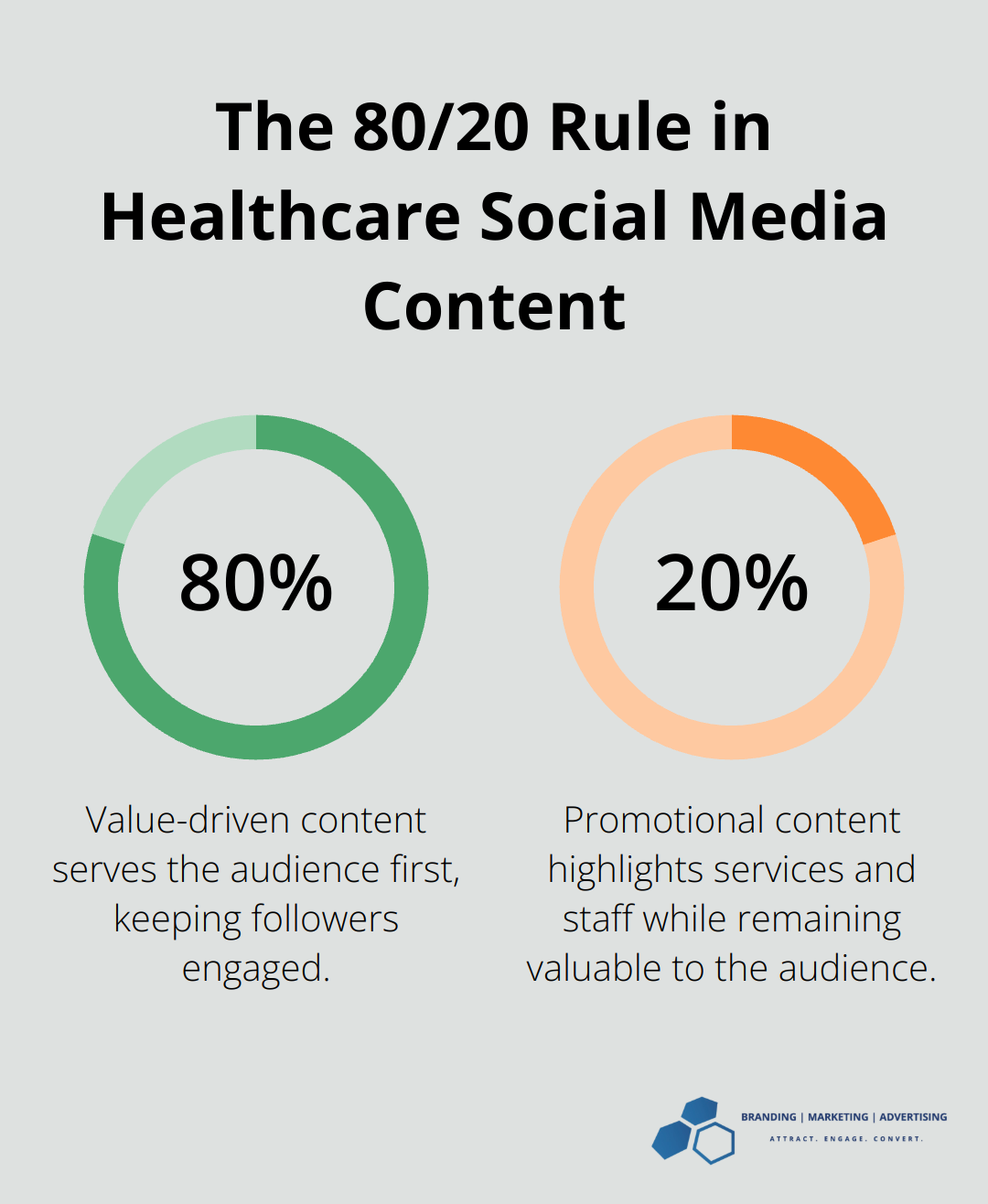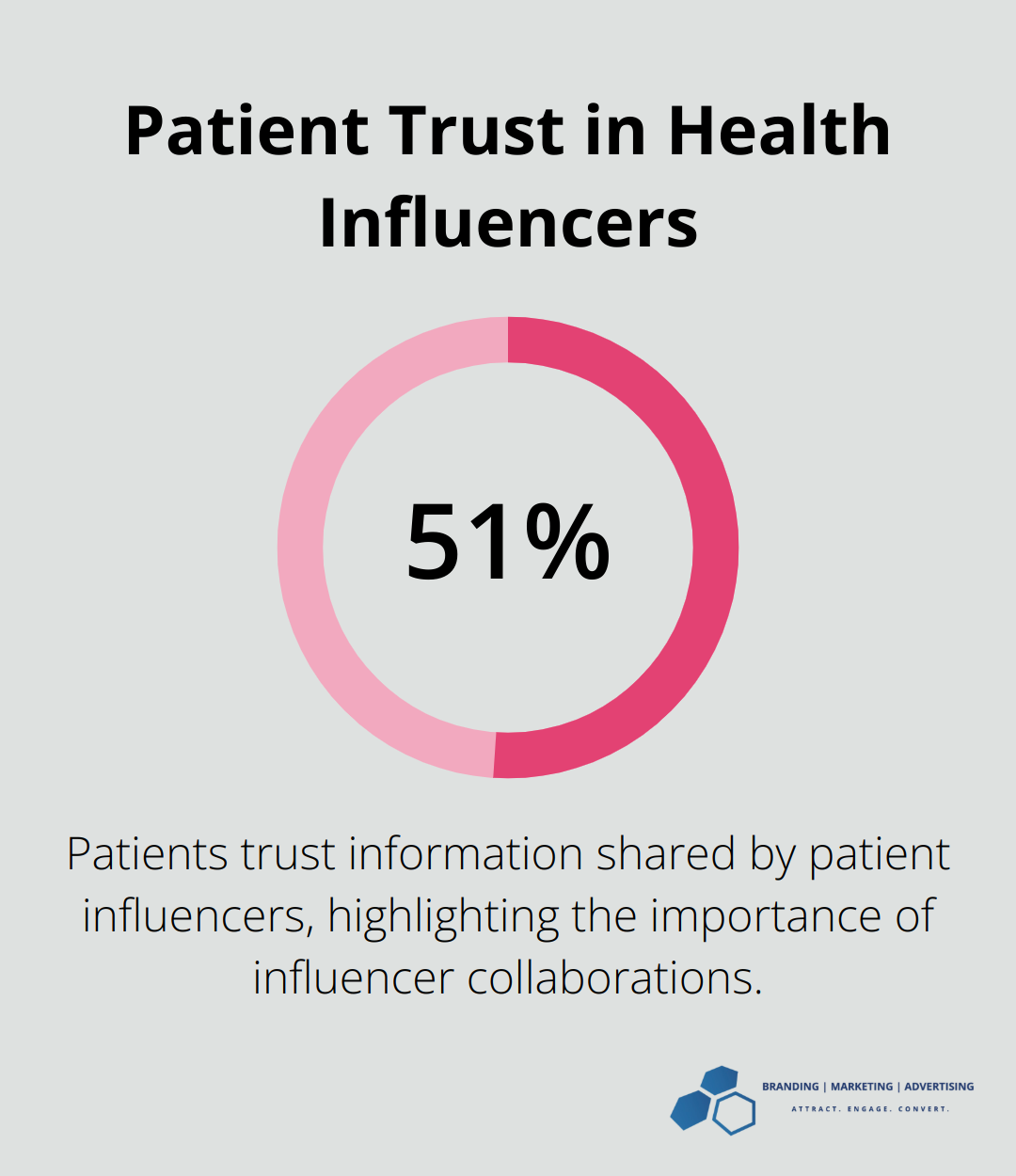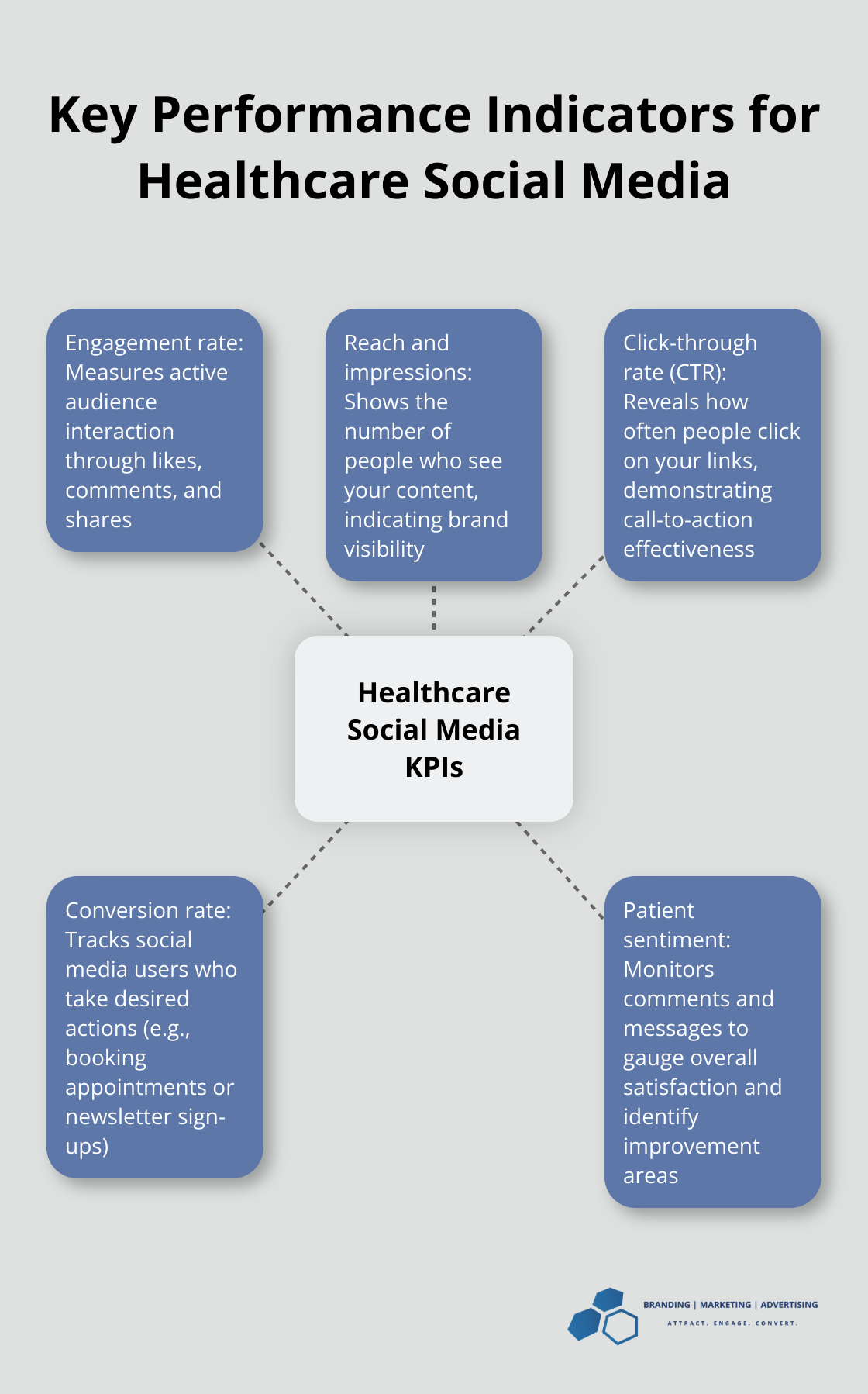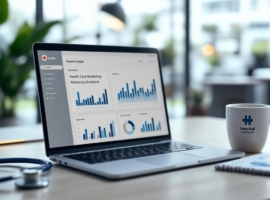How to Master Health Care Social Media Marketing
At Branding | Marketing | Advertising, we’ve seen healthcare social media marketing evolve rapidly in recent years. The digital landscape offers unique opportunities for medical professionals and organizations to connect with patients and build trust.
However, navigating this space requires a delicate balance of compliance, credibility, and engagement. In this post, we’ll explore how to master healthcare social media marketing while adhering to industry regulations and delivering value to your audience.
Navigating the Healthcare Social Media Landscape
Healthcare social media marketing presents unique challenges that require a careful balance of compliance, trust-building, and valuable content creation. This landscape demands a strategic approach to connect with patients effectively while adhering to industry regulations.
Ensuring Compliance in a Regulated Industry
HIPAA compliance is a top priority in healthcare social media marketing. One mistake can result in severe consequences. We recommend creating a comprehensive social media policy that clearly outlines permissible and prohibited content. This policy should undergo regular updates and be communicated to all staff involved in social media activities.
It’s essential to never share patient information without explicit consent. Even seemingly innocent posts can inadvertently reveal protected health information (PHI). For instance, a photo of a waiting room might unintentionally identify patients. Always review all content through a HIPAA compliance lens before posting (and when in doubt, don’t post).
Fostering Trust Through Authentic Communication
Trust forms the foundation of the healthcare industry. Social media provides a unique opportunity to build credibility and connect with patients on a personal level. Sharing behind-the-scenes content, such as staff introductions or facility tours, can humanize your brand and increase patient comfort.
Educational content plays a key role in establishing trust. Share accurate, easy-to-understand health information that addresses common concerns or questions. This approach positions your organization as a reliable information source and demonstrates your commitment to patient education.
Striking the Right Content Balance
While promotional content is important, a balanced approach yields better results. We suggest following the 80/20 rule: 80% of your content offers value, serving your audience first. This keeps followers engaged and invested in your brand without feeling like they’re constantly being sold to.

For educational content, focus on topics relevant to your audience. This could include preventive health tips, explanations of common procedures, or updates on the latest medical research. Present this information in an accessible, jargon-free manner.
For promotional content, be strategic. Highlight unique services, introduce new staff members, or showcase patient success stories (with proper consent). Make these promotions feel natural and valuable to your audience, rather than pushy or sales-oriented.
Leveraging Platform-Specific Strategies
Different social media platforms cater to different audiences and content types. Tailor your approach to each platform:
- Facebook: Ideal for community building and sharing longer-form content.
- Instagram: Perfect for visual storytelling and behind-the-scenes glimpses.
- Twitter: Great for quick updates, health tips, and engaging in industry conversations.
- LinkedIn: Suitable for professional networking and sharing industry insights.
Engaging Authentically with Your Audience
Engagement goes beyond posting content. Respond promptly to comments and messages, addressing concerns and questions professionally. This interaction builds trust and shows that you value patient communication.
Consider hosting Q&A sessions or live streams to directly interact with your audience. These events can provide valuable health information while showcasing your expertise and approachability.
As you master these aspects of healthcare social media marketing, you’ll create a powerful online presence that complies with regulations, builds trust, and provides real value to your audience. The next section will explore effective strategies to maximize your impact across various social media platforms.
Crafting a Winning Healthcare Social Media Strategy
At Branding | Marketing | Advertising, we have developed strategies that consistently deliver results for healthcare organizations. Here’s how you can create a powerful social media presence that resonates with patients and professionals alike.
Content That Connects
Your social media content should address the specific needs and interests of your healthcare audience. Create educational posts that explain complex medical topics in simple terms. Infographics breaking down common health conditions or short video explainers about preventive care measures can be highly effective.
Include patient success stories (with proper consent) to showcase real-world outcomes. These narratives humanize your brand and build trust. A recent study found that improving recruitment through social media and web-based methods can have a significant impact on healthcare choices.
Address current health trends or debunk medical myths. This positions your organization as a reliable source of information in a sea of misinformation. Always cite reputable sources when sharing health data or research findings.
Platform-Specific Strategies
Each social media platform has its unique strengths. Tailor your approach accordingly:
Facebook: Use this platform for longer-form content and community building. Share detailed health articles, host live Q&A sessions with healthcare professionals, and create support groups for specific health conditions.
Instagram: Leverage this platform for visual storytelling. Post behind-the-scenes glimpses of your facility, share quick health tips through Instagram Stories, and use IGTV for in-depth health education videos.
Twitter: Utilize this platform for real-time updates and engaging in healthcare conversations. Share breaking health news, participate in relevant Twitter chats, and offer quick health tips in 280 characters or less.
LinkedIn: Focus on professional networking and thought leadership. Share industry insights, highlight staff achievements, and post about advancements in medical research or technology.
Authentic Engagement
Engagement extends beyond posting content. Create meaningful interactions with your audience. Respond promptly to comments and messages, addressing concerns with empathy and professionalism. This shows that you value patient communication and are committed to providing support.
Implement a social listening strategy to monitor conversations about your brand and relevant health topics. This can provide valuable insights into patient needs and concerns, allowing you to tailor your content and services accordingly.
Host regular live Q&A sessions or AMAs (Ask Me Anything) with healthcare professionals from your organization. This not only provides valuable information to your audience but also showcases the expertise of your staff.
Create hashtag campaigns or contests that align with your healthcare mission to encourage user-generated content. For example, a campaign promoting healthy lifestyle choices could ask followers to share their favorite nutritious recipes or workout routines.
Collaborate with reputable health influencers or patient advocates to expand your reach and credibility. A recent survey found that 51% of patients trust information shared by patient influencers.

Consistency is key in social media marketing. Regularly analyze your performance metrics to refine your approach and stay ahead in the ever-evolving digital landscape. The next section will explore how to measure the success of your healthcare social media marketing efforts and calculate your return on investment.
Tracking Healthcare Social Media Success
At Branding | Marketing | Advertising, we understand the importance of measuring the impact of healthcare social media efforts. This chapter explores effective methods to track and analyze social media performance, driving continuous improvement in your digital marketing strategy.
Defining Key Performance Indicators
Identify the metrics that matter most for your healthcare organization:
- Engagement rate: Measures active audience interaction through likes, comments, and shares.
- Reach and impressions: Shows the number of people who see your content, indicating brand visibility.
- Click-through rate (CTR): Reveals how often people click on your links, demonstrating call-to-action effectiveness.
- Conversion rate: Tracks social media users who take desired actions (e.g., booking appointments or newsletter sign-ups).
- Patient sentiment: Monitors comments and messages to gauge overall satisfaction and identify improvement areas.

Leveraging Analytics Tools
Use platform-specific analytics tools to gather data on social media performance. Facebook Insights, Twitter Analytics, and Instagram Insights provide valuable information on audience demographics, post performance, and engagement trends.
Third-party tools (like Hootsuite or Sprout Social) offer comprehensive analytics across multiple platforms. These tools allow you to track mentions, analyze competitor performance, and generate detailed reports.
Google Analytics 4 (GA4) is a web analytics tool that helps monitor and comprehend the traffic and user engagement on a website or app. Set up UTM parameters for your social media links to accurately attribute traffic and conversions to specific campaigns or posts.
Data-Driven Strategy Refinement
Analyze your social media data regularly to identify trends and opportunities. Look for patterns in high-performing content and replicate successful elements in future posts. If certain types of posts consistently underperform, consider phasing them out or revamping your approach.
Use A/B testing to optimize your social media strategy. Test different post formats, content types, or posting times to see what resonates best with your audience. For example, compare the performance of text-only health tips versus infographics to determine which format drives more engagement.
Pay attention to your audience’s behavior patterns. If you notice increased engagement during specific times or days, adjust your posting schedule to maximize reach and interaction.
Monitor the performance of paid social media campaigns closely. Track metrics like cost per click (CPC) and return on ad spend (ROAS) to ensure you get the most value from your advertising budget. Adjust targeting, ad creative, or bidding strategies based on these insights.
Qualitative Feedback Integration
Social media success in healthcare isn’t just about numbers. While quantitative metrics are important, consider qualitative feedback from patients and staff. This holistic approach ensures your social media strategy aligns with your overall healthcare mission and patient care goals.
Conduct regular surveys or focus groups to gather in-depth insights from your audience. This qualitative data can provide valuable context to your quantitative metrics and help you understand the “why” behind your social media performance.
Implement a system to collect and analyze patient testimonials and reviews shared on social media. These personal stories (shared with proper consent) can offer powerful insights into patient experiences and help you identify areas for improvement in your healthcare services.
By mastering content creation and consistently tracking your social media performance, you can effectively tell your brand’s story and optimize your healthcare organization’s online presence.
Final Thoughts
Healthcare social media marketing has become essential for medical professionals to connect with patients and build trust. We at Branding | Marketing | Advertising understand the importance of balancing compliance, credibility, and engagement in this unique landscape. Our strategies focus on creating educational content that addresses audience needs while incorporating promotional elements strategically.
We tailor our approach to different social media platforms, maximizing impact through platform-specific strengths. Our team engages authentically with audiences by responding promptly to comments, hosting Q&A sessions, and collaborating with reputable health influencers. We regularly analyze social media performance using key metrics and analytics tools to refine strategies and optimize content.
Success in healthcare social media marketing extends beyond numbers. We consider qualitative feedback to align strategies with overall healthcare missions. Our healthcare social media marketing services can help you create a robust online presence that attracts new patients and fosters long-lasting relationships with your existing audience.












